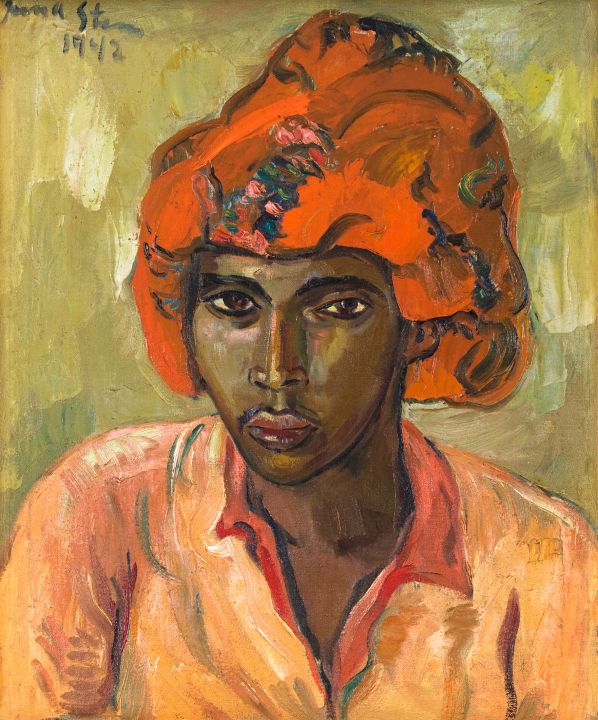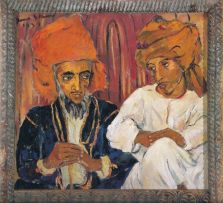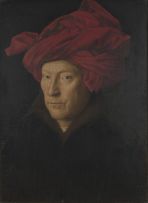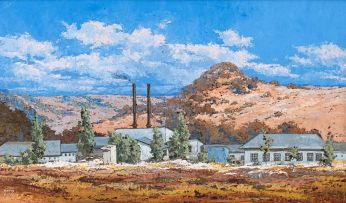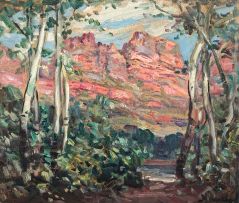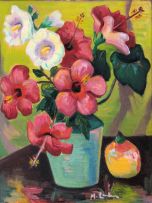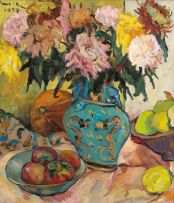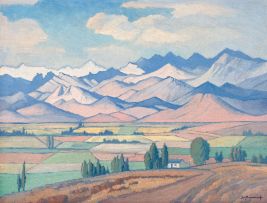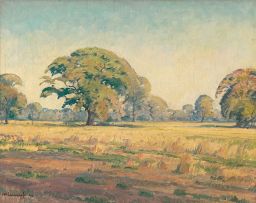Young Arab
Irma Stern
Incl. Buyer's Premium & VAT
About this Item
signed and dated 1942
Notes
Most of Irma Stern's Arab subjects derive from the artist's two visits to Zanzibar in 1939 and 1945 - and she is documented to have made several Young Arab paintings during those visits. Less well-known are the few Arab subjects Stern depicted during her visit to the Congo in mid-1942. Stern had gone to the Congo specifically to paint the Watussi and Mangbetu peoples but along the way - and doubtless prompted by her Zanzibar experience - she painted a few Arab subjects: Stern alludes to these subjects in her book Congo (1943: p.38) "[the Arabs] squat all around, dark bearded men with heavy sallow faces and sad calculating eyes. They wear orange turbans wound around their heads". Some of these paintings were included in her exhibition in Elizabethville at the end of her stay in the Congo; and, again, at her 'Congo Exhibition' at the Gainsborough Gallery, Johannesburg, in December 1942. Both the annotated list of this exhibition that is pasted into the artist's Scrapbook and her Cashbook record that #7 Young Arab was sold for £40 to a Dr Swart. This is almost certainly the present work.
A comparison between the Young Arab and the Two Arabs (Father and Son) (Private Collection; Arnold, p.115) and other work from the first visit to Zanzibar, is revealing. In 1939, Irma Stern was clearly attracted to the exoticism of Zanzibar which she found expressed in colourful costume and, frequently, some form of rhetorical action: figures are represented saying prayers, drinking coffee or, as in the Two Arabs (Father and Son), communicating with each other in some way. Moreover, the early paintings usually incorporate a spatial context for the figure, either a developed architectural setting or an indication of background drapery. This richness of content is expressed in both the relatively large scale of the early works - the Two Arabs (Father and Son) is over twice the size of the Young Arab - and by the artist's use of Zanzibari carved doorways converted into sensuously rich frames. The Young Arab is relatively simple on all these counts and seems never to have had an exotic frame. But where Stern herself would probably have regarded this work as a modest expression, contemporary taste values the removal of the paraphernalia of exoticism to focus on the pure presence of the subject.
Against a backdrop defined more for its harmonious colour relationship with the principal subject than to create any spatial setting, the Young Arab presents himself to the spectator simply as a fellow human subject. According to Joseph Sachs, Irma Stern and the Spirit of Africa, published in 1942, the year this painting was made, Stern's Zanzibar figures, "lulled by [their] inherent indolence and [their] Oriental quietism", represent nothing less than "the rise and fall of Arab civilisation". But the Young Arab is free of these exotic associations and while perhaps questioning the purpose of the pictorial encounter, asserts his shared humanity through the vitality of his eyes and mouth. As in Jan Van Eyck's great Portrait of a Man (Self Portrait?) (National Gallery, London), which Stern had certainly seen, the magnificent headgear provides a note of extravagant ostentation but the deep silence of the figure is enriched by this attribute rather than disrupted. The gestural brushstrokes, whether defining form or enlivening the painted surface, also contribute vitality to the figure without disturbing its silence. The painting is not a portrait in the traditional sense: it lacks the self-referential specificity of works made in that genre and Stern was clearly not concerned with the identity of her subject. But as an essay in the exploration of shared human experience it is rarely matched in Irma Stern's oeuvre.
Michael Godby
Marion Arnold. (1995) Irma Stern: A Feast for the Eye, Vlaeberg: Fernwood Press.
Joseph Sachs. (1942) Irma Stern and the Spirit of Africa, Pretoria: J.L. Van Schaik.
Irma Stern. (1943) Congo, Pretoria: J.L. Van Schaik.
Provenance
Stephan Welz & Co in Association with Sotheby's, Johannesburg, 8 May 1995, lot 268, with the title Young Man with Orange Turban
Exhibited
The Museum of Anthropology, Elizabethville, 1942, catalogue number 1
The Gainsborough Gallery, Johannesburg, Private View - an exhibition of Paintings and Drawings from the Belgian Congo, 24 November - 8 December, 1942
Literature
Wilhelm van Rensburg (ed.)(2003) Irma Stern: Expressions of a Journey. Johannesburg: Standard Bank Gallery. Illustrated in colour on page 73 and on back cover.
Stephan Welz. (1996) Art at Auction in South Africa: The Art Market Review 1969 to 1995, Johannesburg: Art Link (Pty) Ltd. Page 7 and illustrated in colour on page 12.
